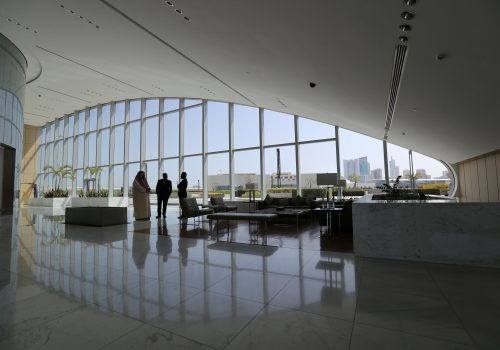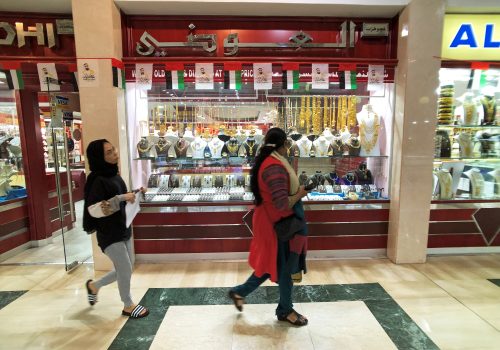Brown-to-green subsidy swaps in MENA are long overdue. Here’s why.
Despite the many improvements on many social, political, and economic fronts over the past few decades, there is significant work—in areas such as wasteful and socially unjust fossil fuel subsidies, air pollution and environmental degradation, youth unemployment, and gender inequalities—to be done in the Middle East and North Africa (MENA) region. While there are significant inter-country or even intra-country variations regarding some of these issues, from a high-level macro perspective, one can identify strong links between these specific issues in the greater MENA.
$2.27 trillion. This is the amount of explicit fossil fuel subsidies paid by MENA governments between 2010 and 2020. According to the International Energy Agency (IEA), MENA economies—led by Iran and Saudi Arabia—accounted for 50 percent of the world’s $4.57 trillion fossil fuel subsidy payments in this period (Figure 1).
Figure 1. Share in total global explicit fossil fuel subsidies between 2010 and 2020 (Percentage)
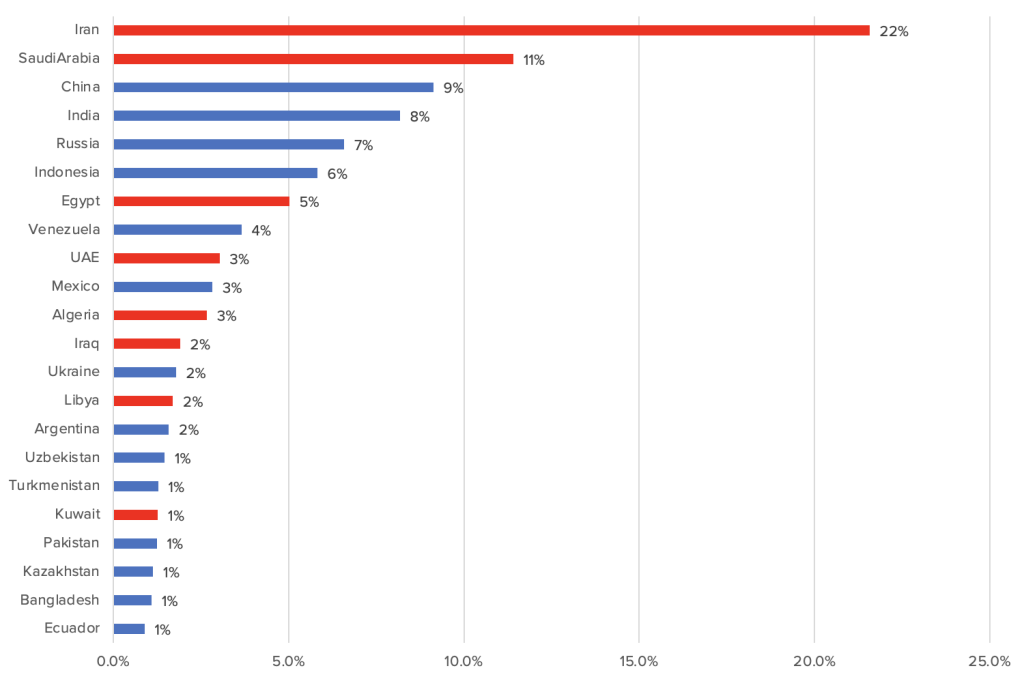
127,000. This is the number of annual pre-mature deaths in MENA related to ambient air pollution—around 7 percent of all deaths in the region. An important factor contributing to the region’s air pollution is the wasteful usage of fossil fuels, which is incentivized by massive fossil fuel subsidies in the region (Figure 2). Post-tax estimates of fossil fuel subsidies that take into account explicit and implicit costs—social, health, forgone taxation, and environmental costs—hover around 16 percent of the region’s GDP or about $5.4 trillion for the 2010-2020 period.
Figure 2. Change in energy use (kg of oil equivalent) per $1,000 GDP between 1990 and 2014
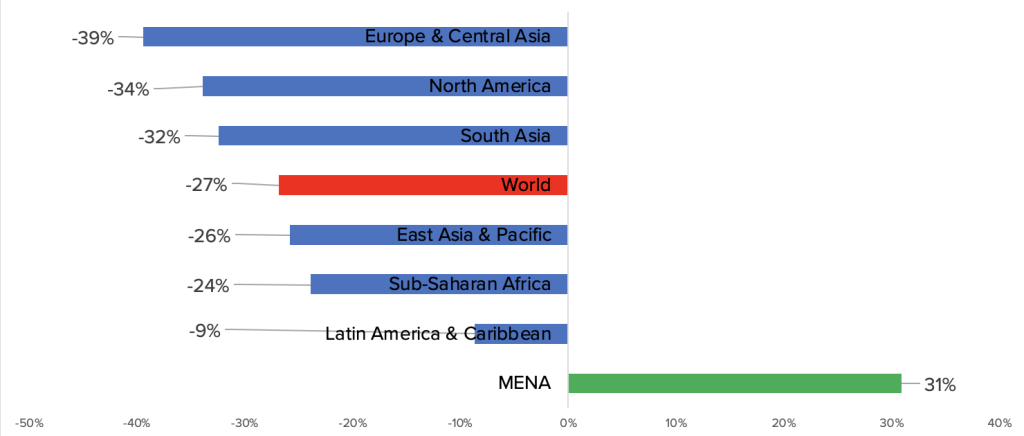
62 percent. This is the share of total fossil fuel subsidies households in the top two income quintiles receive in the MENA region. Fossil fuel subsidies are ineffective in reducing poverty and inequality and can, in fact, lead to more inequality and poverty in an economy by shrinking fiscal space of governments, increasing budget deficits, and heightening inflation rates.
According to a 2015 International Monetary Fund study, MENA households in the top quintile received about 40 percent of all fossil fuel subsidies, while only 9 percent of these subsidies reached those in the bottom quintile.
Fifteen out of one hundred. This is the share of MENA’s entire female population that have formal jobs. It must be noted that, in many MENA economies, women’s labor participation and employment in informal sectors are larger than the formal sector. Gender-related inequalities in many MENA countries represent themselves in many forms and have deep roots in the region’s culture. While there are significant inter-country variations—for example, female labor force participation rates between the ages of fifteen to sixty-four range from 6 percent in Yemen, to 23 percent in Saudi Arabia and Morocco, and 58 percent in Qatar—overall, the remaining cultural biases against female participation in the labor force and the type of industries and jobs deemed “appropriate” for women to work in have translated to significantly less employment opportunities for women, especially young women, across the region.
Only 10 percent of female youths participate in the formal labor market (Figure 4). Even then, 47 percent of female youth are without a job (Figure 5). In other words, only 5.3 percent of female youths in the MENA region are working compared to 30 percent of male youths (Figures 4 and 5). This is especially worrying, as women’s very low participation rate in MENA’s formal labor force—18 percent for females fifteen and above—has meant that less than half of the region’s adults actively participate in the region’s formal labor market. This creates a significant drag on the economy, especially as the region’s population ages in the next few decades.
Figure 3. Labor force participation rates by gender, MENA vs. World (Percentage), 2020.
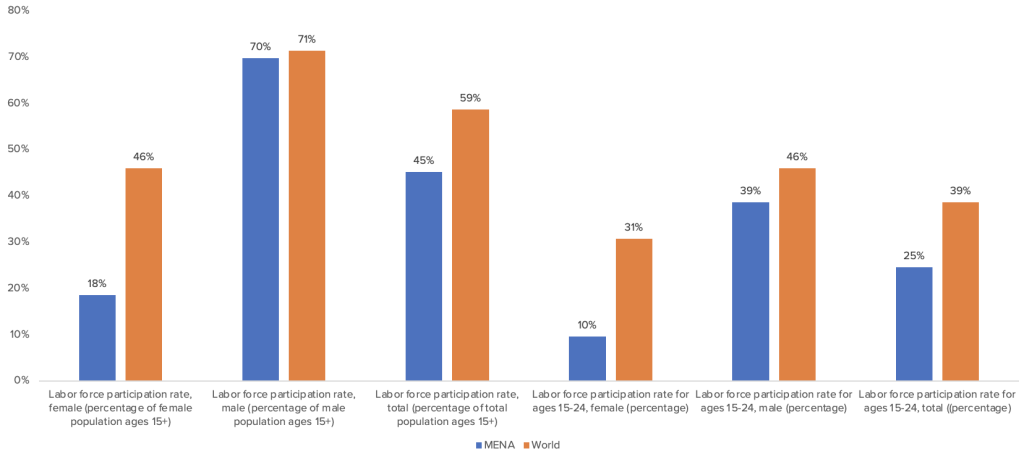
Figure 4. Unemployment rates by gender, MENA vs. World (Percentage), 2020.
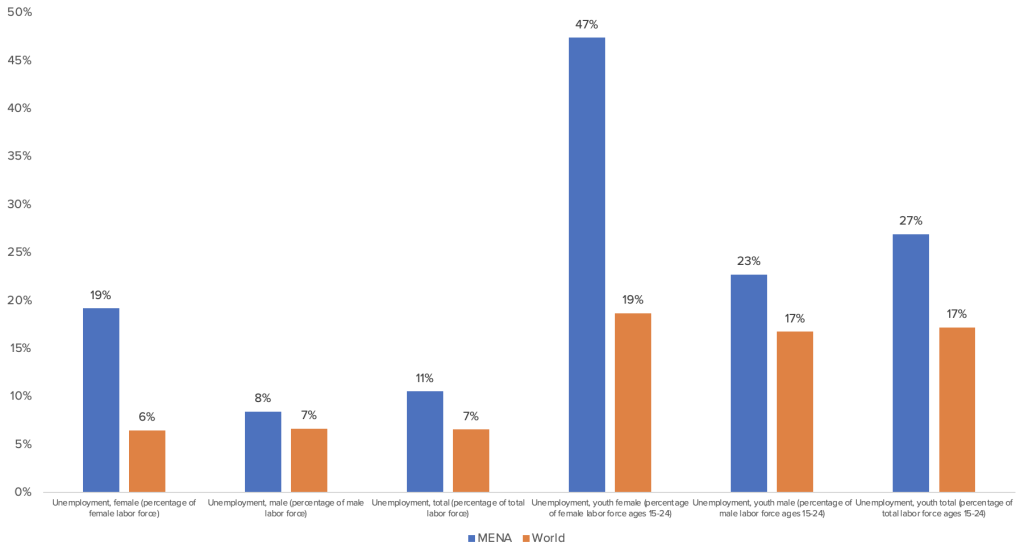
5.7 million. This is the number of net full-time equivalent (FTE) jobs that could have been created in MENA if half of the region’s 2010-2020 explicit fossil fuel subsidies was channeled to the renewable energy sector. Studies show that redirecting $1 million from fossil fuel subsidies towards the renewable energy sector will create five net FTE jobs in an economy. Considering MENA’s immense solar and wind potential, this number is on the conservative side for the region.
Therefore, if only half of 2010-2020 explicit pre-tax fossil fuel subsidies ($1.14 trillion) were directed towards subsidizing the renewable industry in the region, it could have created 5.7 million net jobs in the region over the past decade, according to my calculations. These millions of extra jobs would have been the jobs of the future: all green and the majority in high tech. This would have helped jump-start the region’s high-tech startups, employ the educated and tech-savvy youth of the region, and reduce overreliance on public sector employment. This is critical because, with limited revenues and rapidly rising populations—two-third of the region’s population is below the age of thirty-five—and expenditures, many governments in MENA—especially those in larger countries—have failed to keep up with the growing demands for jobs, resulting in high unemployment rates, especially among the youth.
Channeling all or a portion of fossil fuel subsidies towards the renewable energy sector—also known as brown-to-green subsidy swaps—will not only create much-needed jobs in the region, but will also promote energy efficiency and reduce air pollution and the many costs associated with it, including illnesses and premature deaths. The positive social effects of such massive job creation in MENA’s green and high-tech sector will also be significant. For one, the renewable energy industry is more gender equitable. Available data suggests that, globally, women account for 22 percent of the oil and gas industry workforce, while this number jumps to 32 percent in the renewable energy industry.
This impact would be more pronounced in MENA because almost the entire oil and gas industry in the region is male-dominated. Hence, subsidizing the oil and gas industry simply translates to subsidizing industries that are overwhelmingly male-dominant and less female-friendly, exacerbating and reinforcing the cultural barriers for female employment in the MENA region. Therefore, reducing fossil fuel subsidies and increasing the growth of the renewable energy sector in MENA would translate to even more employment opportunities for young women in the region compared to world averages.
Moreover, reducing fossil fuel subsidies would have tremendous savings for the MENA region in terms of environmental, health, and other implicit costs associated with subsidizing fossil fuel usage. For example, reducing 2010-2020 explicit fossil fuel subsidies by half would have resulted in about $2 trillion in savings for MENA economies—or about 6 percent of the region’s total economic output in 2010-2020.
Poorer households would be the major beneficiary of these savings; studies show that poorer populations depend more on the environment for their livelihood and shoulder the lion’s share of the health, economic, and environmental costs of fossil fuel subsidies.
Thus, in the medium to long run, reducing fossil fuel subsidies will benefit the poor much more than it can hurt them, leading to improvements in MENA’s increasing levels of multidimensional inequality. In the short run, any reforms to fossil fuel subsidies will lead to price increases across the economy, negatively impacting the poor. In response, governments must enact targeted social protection policies that would mitigate negative short-run impacts of fossil fuel subsidy reductions or removals.
To conclude, reforms in fossil fuel subsidies can help address many challenges and could result in many benefits for the MENA region. However, such reforms have faced serious obstacles in the region and have often led to social unrest and public resentment in various countries. Social unrest and violent protests in Iran in November 2019 and Lebanon in 2021 are cases in point. On the other hand, in 2006, Indonesia successfully eliminated most gasoline and diesel subsidies and channeled the resulting savings to finance economic and social development.
Considering their many environmental, economic, and social benefits, following Indonesia’s model of brown-to-green subsidy swaps could help reduce public resistance against such reforms, while also paving the path for a more energy-secure future in MENA and other regions. Of course, this will not be an easy reform process, but leaders in the MENA region must take it seriously and start looking into the details considering the specific political-economic environments of their countries.
Figure 6. Potential benefits of reducing/eliminating fossil fuel subsidies
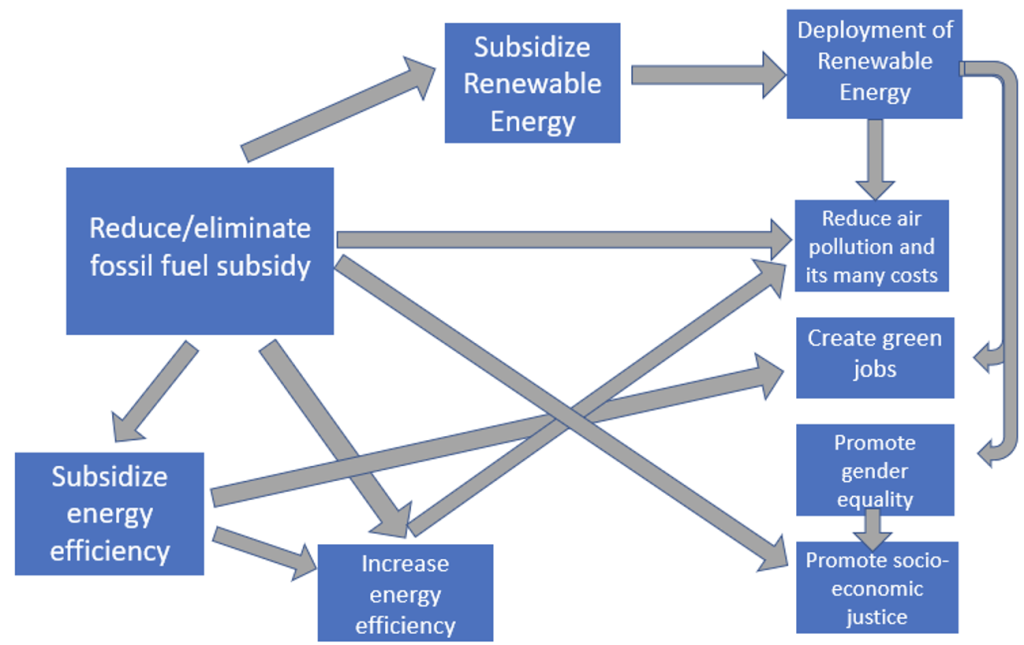
Amin Mohseni-Cheraghlou is a macroeconomist with the GeoEconomics Center and an assistant professor of Economics at the American University in Washington. Follow him on Twitter: @AMohseniC.
Further reading
Mon, Mar 8, 2021
Celebrating MENA women entrepreneurs and business leaders
MENASource By
In honor of International Women’s Day, the Atlantic Council’s empowerME asked Middle East business leaders and government officials to share a "shout out" about a woman entrepreneur or business leader who inspires them
Fri, Oct 29, 2021
FinTech in MENA: How to build an ecosystem that promotes innovation and regulation
Event Recap By Stefanie Hausheer Ali
The Atlantic Council’s empowerME Initiative in partnership with ABANA is convening a virtual event series to shed light on the changing FinTech landscape in the MENA region, identify challenges and opportunities, and explore policy recommendations.
Wed, Mar 31, 2021
Family businesses in the Gulf must not be left behind
MENASource By
Research suggests that family-owned businesses contribute about 60 percent of the gross domestic product in the GCC countries and employ more than 80 percent of its labor force.
Image: Palestinian engineers work at a workshop to generate electric power through solar cells in the northern Jordan Valley in the West Bank. Many Palestinian residents have resorted to using solar energy cells as a primary source of electricity in light of the high electricity prices. (Photo by Nasser Ishtayeh / SOPA Images/Sipa USA)No Use Germany.

